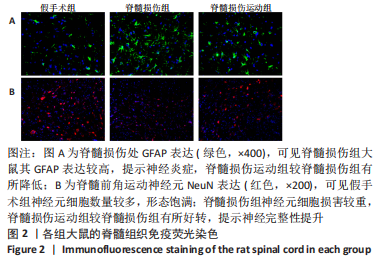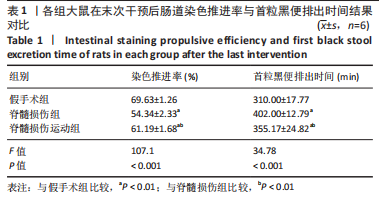[1] SIMPSON LA, ENG JJ, HSIEH JT, et al. The health and life priorities of individuals with spinal cord injury: a systematic review. J Neurotrauma. 2012;29(8):1548-1555.
[2] ANDERSON KD. Targeting recovery: priorities of the spinal cord-injured population. J Neurotrauma. 2004;21(10):1371-1383.
[3] EBERT E. Gastrointestinal involvement in spinal cord injury: a clinical perspective. J Gastrointestin Liver Dis. 2012;21(1):75-82.
[4] PARKMAN HP. Scintigraphy for evaluation of patients for GI motility disorders--the referring physician’s perspective. Semin Nucl Med. 2012; 42(2):76-78.
[5] SARNELLI G, D’ALESSANDRO A, PESCE M, et al. Genetic contribution to motility disorders of the upper gastrointestinal tract. World J Gastrointest Pathophysiol. 2013;4(4):65-73.
[6] JING Y, YU Y, BAI F, et al. Effect of fecal microbiota transplantation on neurological restoration in a spinal cord injury mouse model: involvement of brain-gut axis. Microbiome. 2021;9(1):59.
[7] HEINEMANN U, SCHUETZ A. Structural Features of Tight-Junction Proteins. Int J Mol Sci. 2019;20(23):6020.
[8] EVANS CC, LEPARD KJ, KWAK JW, et al. Exercise prevents weight gain and alters the gut microbiota in a mouse model of high fat diet-induced obesity. PloS one. 2014;9(3):e92193.
[9] CHOI J, EUM S, RAMPERSAUD E, et al. Exercise attenuates PCB-induced changes in the mouse gut microbiome. Environ Health Perspect. 2013; 121(6):725-730.
[10] PETRIZ BA, CASTRO AP, ALMEIDA JA, et al. Exercise induction of gut microbiota modifications in obese, non-obese and hypertensive rats. BMC Genomics. 2014;15(1):511.
[11] CLARKE SF, MURPHY EF, O’SULLIVAN O, et al. Exercise and associated dietary extremes impact on gut microbial diversity. Gut. 2014;63(12): 1913-1920.
[12] WANG H, LIU N, ZHANG Y, et al. Treadmill training induced lumbar motoneuron dendritic plasticity and behavior recovery in adult rats after a thoracic contusive spinal cord injury. Exp Neurol. 2015;271:368-378.
[13] WARD PJ, HERRITY AN, HARKEMA SJ, et al. Training-Induced Functional Gains following SCI. J Neural plasticity. 2016;2016:4307694.
[14] LAMBERT GP, BROUSSARD LJ, MASON BL, et al. Gastrointestinal permeability during exercise: effects of aspirin and energy-containing beverages. J Appl Physiol. 2001;90(6):2075-2080.
[15] SHAO C, LI Y, CHEN J, et al. Physical Exercise Repairs Obstructive Jaundice-Induced Damage to Intestinal Mucosal Barrier Function via H2S-Mediated Regulation of the HMGB1/Toll Like Receptors 4/Nuclear Factor Kappa B Pathway. Front Physiol. 2021;12:732780.
[16] VAN NIEUWENHOVEN MA, BROUNS F, BRUMMER RJ. Gastrointestinal profile of symptomatic athletes at rest and during physical exercise. Eur J Appl Physiol. 2004;91(4):429-434.
[17] KIM JY, CHOI GS, CHO YW, et al. Attenuation of spinal cord injury-induced astroglial and microglial activation by repetitive transcranial magnetic stimulation in rats. J Korean Med Sci. 2013;28(2):295-299.
[18] CHOI DC, LEE JY, LIM EJ, et al. Inhibition of ROS-induced p38MAPK and ERK activation in microglia by acupuncture relieves neuropathic pain after spinal cord injury in rats. Exp Neurol. 2012;236(2):268-282.
[19] TATE DG, FORCHHEIMER M, RODRIGUEZ G, et al. Risk Factors Associated With Neurogenic Bowel Complications and Dysfunction in Spinal Cord Injury. Arch Phys Med Rehabil. 2016;97(10):1679-1686.
[20] 尚云龙,李一帆,宁云峰,等.大鼠脊髓损伤模型的解剖学参考定位[J].解剖学研究,2013,35(6):412-414+481.
[21] WU Q, CAO Y, DONG C, et al. Neuromuscular interaction is required for neurotrophins-mediated locomotor recovery following treadmill training in rat spinal cord injury. PeerJ. 2016;4:e2025.
[22] KIM YM, JIN JJ, LEE SJ, et al. Treadmill exercise with bone marrow stromal cells transplantation facilitates neuroprotective effect through BDNF-ERK1/2 pathway in spinal cord injury rats. J Exerc Rehabil. 2018; 14(3):335-340.
[23] CHIO CC, LIN JW, CHANG MW, et al. Therapeutic evaluation of etanercept in a model of traumatic brain injury. J Neurochem. 2010;115(4):921-929.
[24] RIVLIN AS, TATOR CH. Objective clinical assessment of motor function after experimental spinal cord injury in the rat. J Neurosurg. 1977;47(4): 577-581.
[25] LIU CW, HUANG CC, YANG YH, et al. Relationship between neurogenic bowel dysfunction and health-related quality of life in persons with spinal cord injury. J Rehabil Med. 2009;41(1):35-40.
[26] PREZIOSI G, RAPTIS DA, RAEBURN A, et al. Autonomic rectal dysfunction in patients with multiple sclerosis and bowel symptoms is secondary to spinal cord disease. Dis Colon Rectum. 2014;57(4):514-521.
[27] 逯晓蕾,李建军,杜良杰,等.脊髓损伤后肠道功能的变化[J].中国康复理论与实践,2010,16(8):758-760.
[28] PETERSEN AM, PEDERSEN BK. The anti-inflammatory effect of exercise. J Appl Physiol. 2005;98(4):1154-1162.
[29] CARLESSI A, BORBA L, ZUGNO A, et al. Gut microbiota-brain axis in depression: The role of neuroinflammation. Eur J Neurosci. 2021;53(1): 222-235.
[30] 王晨宇,寇冠,王治坤,等.有氧运动对实验性结肠炎小鼠氧化应激、炎症反应及细胞凋亡的影响[J].中华物理医学与康复杂志, 2021,43(4):301-305.
[31] ZHANG JD, LIU J, ZHU SW, et al. Berberine alleviates visceral hypersensitivity in rats by altering gut microbiome and suppressing spinal microglial activation. Acta Pharmacol Sin. 2021;42(11):1821-1833.
[32] SCHMIDT EKA, TORRES-ESPIN A, RAPOSO PJF, et al. Fecal transplant prevents gut dysbiosis and anxiety-like behaviour after spinal cord injury in rats. PloS One. 2020;15(1):e0226128.
[33] 梁家琪,刘恒旭,阳金鑫,等.运动与肠道菌健康效益的关系[J].中国组织工程研究,2023,27(8):1292-1299.
[34] LI X, MAO M, ZHANG Y, et al. Succinate Modulates Intestinal Barrier Function and Inflammation Response in Pigs. Biomolecules. 2019;9(9):486.
[35] CHELAKKOT C, GHIM J, RYU SH. Mechanisms regulating intestinal barrier integrity and its pathological implications. Exp Mol Med. 2018; 50(8):1-9.
[36] KATSANOS KH, PAPADAKIS KA. Inflammatory Bowel Disease: Updates on Molecular Targets for Biologics. Gut Liver. 2017;11(4):455-463.
[37] HUO J, XU S, LAM KP. FAIM: An Antagonist of Fas-Killing and Beyond. Cells. 2019;8(6):541.
[38] LIU F, WANG X, GENG H, et al. Interferon-γ inhibits sirtuin 6 gene expression in intestinalepithelial cells through a microRNA-92b-dependent mechanism. Am J Physiol Cell Physiol. 2020;318(4): C732-C739.
[39] BECKER C, WATSON AJ, NEURATH MF. Complex roles of caspases in the pathogenesis of inflammatory bowel disease. Gastroenterology. 2013; 144(2):283-293.
[40] FRIEDRICH M, POHIN M, POWRIE F. Cytokine Networks in the Pathophysiology of Inflammatory Bowel Disease. Immunity. 2019;50(4): 992-1006.
|







